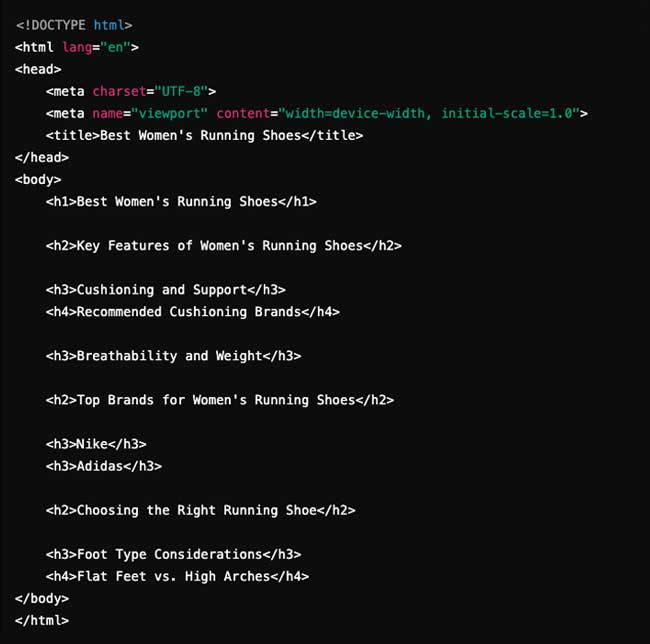Header tags (H1-H6) play an important role in structuring web content. They help search engines understand the hierarchy of information on a page, improving SEO. They also enhance user experience by making content easier to read and navigate. In this article, we will explore the role of header tags in SEO, explain how to use them effectively, and provide examples of both good and poor practices.
What Are Header Tags?
Header tags are HTML elements that define the headings and subheadings within your content. These tags range from H1 to H6, with H1 being the most important and H6 the least. Each level indicates a different level of importance in your content.
H1: This is the main title of your page. It’s the first thing both users and search engines see, so it must be clear and relevant to the content.
H2: These are subheadings used for major sections of the content. They help break up text, making it more readable.
H3-H6: These tags are used for further subsections under the H2 headings. They add more detail and structure without overwhelming the reader.

Why Header Tags Matter for SEO
Header tags serve two primary functions:
- Improving Readability: A well-structured page with clear headings is easier for users to read. People can quickly scan the headings and subheadings to find the information they need.
- Search Engine Optimisation: Search engines use header tags to understand the structure of the content. Proper use of header tags helps search engines prioritise information and assess its relevance to a search query.
Best Practices for Using Header Tags
Use One H1 Tag Per Page
The H1 tag should encapsulate the main topic of your page. It’s the primary signal to both users and search engines about what the page is about. Typically, there should only be one H1 tag per page to avoid confusion.
Good Practice Example:
- H1: “Best Running Shoes for Women in 2024”
- H2: “Key Features of High-Performance Running Shoes”
- H2: “Top Women’s Running Shoe Brands”
Here, the H1 provides a clear title, and the H2 tags further organise the content into major sections.
Poor Practice Example:
- H1: “Running Shoes for Women”
- H1: “Find the Best Footwear for Running”
Using two H1 tags can confuse both users and search engines.
Use H2 Tags for Major Sections
H2 tags should be used to break your content into logical sections. These sections are typically the most important topics after the main page title.
For example:
- H2: “Top Features to Look for in Women’s Running Shoes”
- H2: “Best Running Shoes for Different Foot Types”
These H2 tags clearly divide the content into relevant sections, making it easier for both users and search engines to navigate.
Include Keywords Naturally
While it’s important to include keywords in your headers, the focus should be on readability. Avoid cramming keywords unnaturally into your headers.
Good Practice Example:
- H1: “Best Running Shoes for Women: A Comprehensive Guide”
- H2: “Key Features to Consider When Buying Women’s Running Shoes”
Here, the primary keyword “running shoes for women” is used in a way that feels natural and adds value to the content.
Poor Practice Example:
- H1: “Women’s Running Shoes and Best Running Shoes for Women” This type of keyword stuffing reduces readability.
Follow a Logical Hierarchy
Your headers should follow a logical progression, from H1 (the main topic) to H2 (major sections), then down to H3-H6 for more detailed breakdowns. Skipping levels (e.g., going from H1 directly to H4) can disrupt this flow.
For instance:
- H1: “Best Running Shoes for Women”
- H2: “Top Features to Look for”
- H3: “Breathability”
- H4: “Best Mesh Materials for Running Shoes”
This logical hierarchy helps maintain the structure and ensures users can follow the content with ease.
Poor Practice Example:
- H1: “Running Shoes for Women”
- H4: “How to Find the Best Shoes” Skipping straight to an H4 from an H1 disrupts the natural flow of the content.
Keep Headers Clear and Concise
Your headers should be informative but brief. Overly long or complex headings can be hard to read and may reduce the impact of the content.
Good Practice Example:
- H2: “How to Choose the Right Running Shoes”
- H3: “Factors to Consider for Different Foot Types”
These headers are straightforward, offering clear value to the reader without unnecessary complexity.
Poor Practice Example:
- H2: “Everything You Need to Know About Buying the Best Women’s Running Shoes for All Foot Types and Running Styles” This heading is far too long.
Avoid Overloading Headers
While it’s essential to include relevant keywords in your headers, stuffing too many into one tag can look spammy.
For example, avoid:
- H1: “Best Women’s Running Shoes for Running, Jogging, and Walking in 2024” This is too cluttered with variations of the same and detracts from the overall clarity.
Common Mistakes with Header Tags
- Using Multiple H1 Tags: The H1 tag should be unique to the page. Using more than one can create confusion, both for readers and search engines.
- Skipping Header Levels: Always maintain a logical flow with your header tags. Skipping from an H2 to an H4, for example, disrupts the content structure and makes it harder to follow.
- Keyword Stuffing: Avoid cramming keywords into every header. This practice not only hurts readability but can also be penalised by search engines.
- Ignoring User Experience: While it’s important to optimise for SEO, never lose sight of the user experience. Your content should be easy to read, engaging, and helpful.
Conclusion
By mastering the use of header tags, you’ll enhance your site’s SEO performance and provide a better experience for your readers. Make sure to regularly audit your content to ensure your header tags are working effectively.
